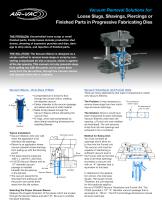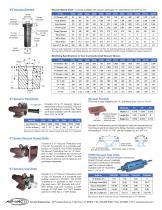
Catalog excerpts

Vacuum Removal Solutions for: Loose Slugs, Shavings, Piercings or Finished Parts in Progressive Fabricating Dies The Problem: Uncontrolled loose scrap or small finished parts. Costly losses include; production shut downs, shearing of expensive punches and dies, damage to strip stock, and rejection of finished parts. The Solution: The Vacuum Sleeve is designed as a simple method to remove loose slugs or scrap by converting compressed air into a vacuum, which is applied at the die opening. This vacuum not only prevents slugs from pulling out with the punch, but it carries them away from the die surface, through the vacuum source, and deposits them into a container. Vacuum Sleeve - How Does It Work Vacuum Vacuum Transducer and Funnel Units • Compressed air is forced to flow through the circular orifice, creating the required vacuum. • Center chamber is the vacuum passage and allows removal of solid material. • Metal scrap passes through the Vacuum Sleeve without disrupting the vacuum flow. • O-rings, which seal compressed air, allow liberal machining dimensions for installing Sleeves. Typical Installation: • Vacuum Sleeves work very well when the application is for individual die openings. • Shown is an application where vacuum prevents loose shavings from pulling up with the trimming punch. • The loose shaving measures .640”L x .030”W x .020 thick. • A VS750 Vacuum Sleeve with an .75” diameter vacuum passage is installed Air Inlet beneath the die opening Vacuum Sleeve in the die bed. • The vacuum prevents the shavings from pulling up with the punch and carries them away from the die surface. Trimming Punch Sliver Exhausted There are many applications that make it impractical to install only Vacuum Sleeves. The Problem: It was necessary to remove loose slugs from two notchings and seven piercings. Two notches at .049 in2 each Six piercings at .012 in2 each The Solution: Since it would have been impractical to place individual Vacuum Sleeves under each die opening, a Funnel unit was installed (as illustrated). The unit removes scrap from all nine openings and exhausts it into a container. Method for Sizing Unit: You must consider all openings which allow air to flow into the Funnel unit. The vacuum unit must be capable of maintaining a sufficient vacuum level in the Funnel. Add up the total area of all these openings and select a vacuum unit with an “A” diameter that is equivalent to this area. Selecting the Proper Vacuum Sleeve: Measure the longest dimension of the pieces which are to pass through the Vacuum Sleeve and add 1/8”. Be sure to consider the stock thickness. In reference to the application shown, this total area equals .182 square inches. Therefore, the unit required for this particular application is a VT500F2 Vacuum Transducer and Funnel Unit. The VT500 provides a 1/2” “A” diameter vacuum passage that is equivalent to .196 in.2. The F2 Funnel flange dimensions include all seven piercings.
Open the catalog to page 1
Vacuum Sleeve Chart - 12 sizes available with vacuum passages (“A” diameters) from 3/16” to 2.0”. O-rings prevent air leakage Overall length Flange Thickness Compressed air inlet holes Flange Diameter Flange thickness Overall Length Vacuum passage “A” diameter Part No. “A” Diameter +.003 Body Diameter Flange diameter Body diameter Vacuum was measured in inches of mercury. For optimum air flow, an operating pressure of 60 psi (max) is recommended. The standard VS190 through VS940 Sleeves are made of steel. Standard VS1250 through VS2000 are made of aluminum. Machining Specifications on how...
Open the catalog to page 2All Air-Vac Engineering catalogs and technical brochures
-
HAVR093HSS
1 Pages
-
TD
1 Pages
-
AV191H
1 Pages
-
RAV
1 Pages
-
AVR
1 Pages
-
Vacuum Generator Literature
4 Pages
-
Vaccum slleve inserts
2 Pages
-
MFL series
2 Pages
-
TD series
4 Pages
-
AVR series
3 Pages











